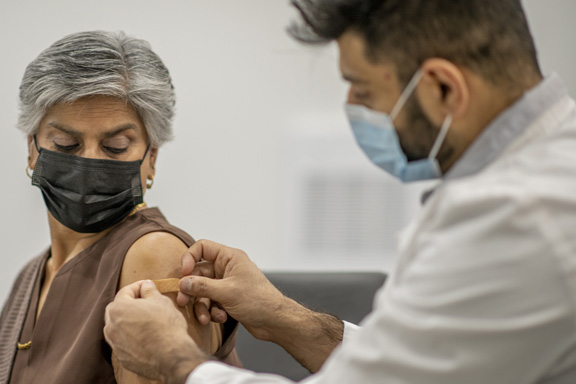*Disclaimer: This article was published in 2020 and reflects the information available at that time.
NSW Health has commenced vaccination audits in community pharmacies to ensure they comply with all procedures necessary to safely vaccinate the public. If areas of non-compliance are identified, it is likely that the pharmacy and pharmacists involved in vaccination will be reported to the Pharmacy Council of NSW or NSW Health. Auditors will check off a set list of items and will rate the pharmacy with a traffic light system; red for total and dangerous non-compliance, orange/yellow for requiring some remedial action, or green for being satisfactory.
Any aspect of the NSW Pharmacist Vaccination Standards may be assessed as part of the audit, including:
- Pharmacist training
- Recording vaccinations
- Practice standards
- General requirements
- Administration area and equipment
- Patient consent and eligibility
- Recording and reporting
- Storage and handling
- Post vaccination patient care
- Management of adverse effects
PDL members are encouraged to perform a self-audit covering every aspect of their vaccination process. The PSA has developed an audit tool that is available to PSA members only. Alternatively, the NSW Pharmacists Vaccination Standards are freely available on the NSW government website.
PDL has identified several areas of focus. However, this is not an exhaustive list of what will be assessed.
Appropriate training
Evidence of vaccination training and certificates of currency are important. This would include first aid (every 3 years)and CPR training(annually) in addition to ASCIA anaphylaxis training in line with requirements. As well as confirming currency, the assessor may ask questions to ensure you can describe what to do in an emergency e.g. the compression rate as per current CPR guidelines, administration of adrenaline for anaphylaxis.
The Standard does not define the requirements of the “appropriately trained” staff member who must be present during vaccination. It is understood that this can be any member of the pharmacy staff. However, it is recommended that this staff member have a current First Aid and CPR certificate and has completed ASCIA (Australasian Society of Clinical Immunology and Allergy) anaphylaxis training.
Correct vaccination procedures
- Able to demonstrate knowledge and/or documentation of the range of vaccines approved for administration by a pharmacist including age ranges.
- Supporting documentation on display in vaccination area which may include protocols, first aid guidance, recommendations for patients to remain in pharmacy for 15 minutes post-vaccination.
- The AIR must be checked prior to vaccination to ensure the person is a suitable candidate for vaccination.
Please note that the pharmacist must not vaccinate a person with a contra-indication or precaution to vaccination listed in the Australian Immunisation Handbook. Pharmacists must be familiar with contraindications and know where to find them under each individual disease entry in the Immunisation Handbook.
Appropriate vaccination environment and equipment
Suitable area to undertake vaccination as per guidelines and considering factors such as;
– Ability to manage adverse events including sufficient space and equipment
- Anaphylaxis management equipment is available and sufficient dating prior to expiry
- Documentation to assist staff in the case of anaphylaxis
- Epipens in anaphylaxis kits are not acceptable as per Immunisation Handbook
– Ability to maintain privacy
– Appropriate infection control measures and equipment
– Accessible copy of Immunisation Handbook for reference
Appropriate storage of vaccines with temperature control and recording systems must be in place.
‘Strive for 5’ information is available and protocol in place for managing situations such as refrigerator alarm or failure. Please note that all vaccine refrigerators should have a permanent data logger in place to continuously measure the refrigerator temperature at pre-set 5-minute intervals. The data should be downloaded at least weekly, in addition to twice-daily minimum/maximum recordings. The data logger can be a portable digital data logger or may be built into the refrigerator.
Record keeping
- Records must be kept in a manner that allows retrieval for a minimum of 7 years.
- Pharmacists need to be able to demonstrate the documentation provided to a client and that consent is provided by the client. The age for medical consent in NSW is 14 years and over – ensure this is captured in the pre-vaccination and consent process.
- Demonstration of process or documentation provided to ensure the client is aware of the need to remain in the pharmacy for at least 15 minutes.
- Demonstrate that AIR is updated following vaccination.
Adverse events
Pharmacists must be able to describe common adverse effects and recognise the signs and symptoms of more serious events such as anaphylaxis or a vasovagal episode. Please note that the NSW Vaccination Standards include a requirement that the pharmacist must notify the immunisation section of the local public health unit by telephone on 1300 066055 if there is a patient that experiences an adverse event following immunisation. In addition to this, an AEFI reporting form must be completed.
The Standard relates to vaccination by suitably qualified pharmacists in compliant premises. If pharmacies intend to utilise a nurse vaccinator, they should contact NSW Health or the organisation arranging the nurse’s services to ensure the pharmacy is complying with all legislative requirements.
PDL members can call 1300 854 838 for advice and incident support from one of our Professional Officers. Supporting our pharmacist members 24/7.



